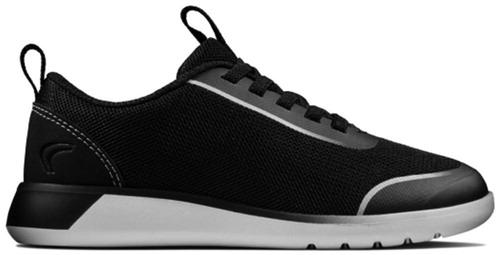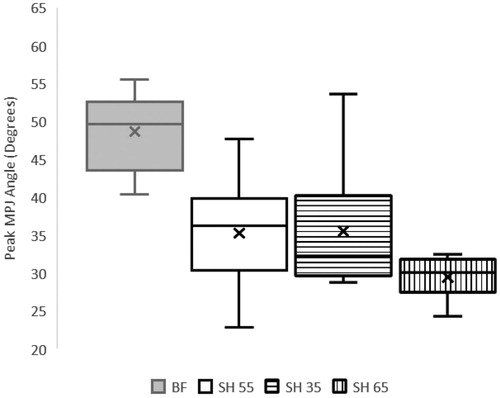Introduction
Flexibility is a widely marketed footwear characteristic. It is often listed as a ‘reason to buy’, by brands and consumers as it is assumed to be associated with a reduced risk of interfering with foot development. However, shoes have been shown to reduce metatarsophalangeal joint (MPJ) motion (Wegener et al., Citation2015) and inflexible footwear decreased foot muscle strength (Goldmann et al., Citation2013) and gait efficiency (Wegener et al., Citation2015; Wolf et al., Citation2008). Sole thickness and sole material type both affect shoe flexibility but neither have been investigated systematically in children’s footwear.
Purpose of the study
The purpose of this study was to investigate the effect of sole density (hardness) on MPJ flexion in children during propulsion.
Methods
Ten healthy children (6 Female) aged 4–7 years (Mean 5.4 years ± 0.8 years) were assessed while walking barefoot (BF), in an on-market product (SH55) (55 ± 3 Asker C), a softer version (SH35) (35 ± 3 Asker C), and a harder version (SH65) (65 ± 3 Asker C). The shoe had a single density ethylene vinyl acetate mid/outsole (). Sole hardness was manipulated to alter sole stiffness. It has been assumed that increased hardness results in increased stiffness. Mechanical testing is to be undertaken to quantify this.
Kinematic data (Qualisys, 100 Hz) was collected using 26.5 mm markers on the right limb and four tracking markers on the left foot (for event detection). Markers were placed on the shoe rather than cutting the upper because shoe flexibility was the independent variable and is affected by the upper structure. A static trial and virtual foot model defined MPJ 0°. Gait events were defined using foot velocity (O'Connor et al., Citation2007). Peak MPJ angle during 55–100% of the stance phase was quantified using Visual 3 D (C-Motion Inc., MD, USA). Normality was determined and peak MPJ angle was compared using a repeated measures ANOVA. Footwear conditions were presented as percentage change from BF for comparison.
Results
The largest MPJ dorsiflexion angle occurred during barefoot walking (mean = 49° ± 5°). All shoes significantly reduced peak MPJ angle compared with barefoot walking (p≤0.05). The MPJ flexion angle was 26% (mean = 35° ± 8°), 27% (mean = 35° ± 7°) and 39% (mean = 29° ± 2°) less than in barefoot walking in SH35, SH55 and SH65 respectively. The largest shod flexion angle occurred in the most flexible shoe (SH35). The difference between most and least flexible shoes (14%) was not statistically significant (p ≥ 0.05) ().
Discussion and conclusion
Mean peak MPJ angles between SH35 and SH55 are similar despite a larger difference in hardness compared to that between SH55 and SH65. The low variability of MPJ angle in SH65 suggests that hardness values above 55 Asker C restrict motion at the MPJ. Mean values between SH35 and SH55 are similar, though variability is greater for both conditions than that in SH65. Altering sole hardness enables greater motion at the MPJ, though its ability to increase MPJ flexion is limited. Material thickness and compound type should be further evaluated when aiming to provide maximal MPJ flexion.
Increasing sole hardness reduces shoe flexibility which systematically decreases MPJ dorsiflexion during propulsion in children. It is assumed that compensations at the ankle or knee might mitigate the effect of reduced MPJ motion due to variations in shoe sole flexibility. While these proximal adaptations may maintain gait efficiency, foot muscle strength could still be impacted. Footwear manufacturers should be aware of the evidence for the association between design decisions, product characteristics, and foot biomechanics. Further investigation is required to determine the effects of sole hardness and flexibility in younger children.
Additional information
Funding
References
- Goldmann, J., Potthast, W., & Brüggemann, G. (2013). Athletic training with minimal footwear strengthens toe flexor muscles. Footwear Science, 5(1), 19–25. https://doi.org/10.1080/19424280.2012.744361
- O'Connor, C. M., Thorpe, S. K., O'Malley, M. J., & Vaughan, C. L. (2007). Automatic detection of gait events using kinematic data. Gait and Posture, 25, 469–474. https://doi.org/10.1016/j.gaitpost.2006.05.01
- Wegener, C., Greene, A., Burns, J., Hunt, A., Vanwanseele, B., & Smith, R. (2015). In-shoe multi-segment foot kinematics of children during the propulsive phase of walking and running. Human Movement Science, 39, 200–211. https://doi.org/10.1016/j.humov.2014.11.002
- Wolf, S., Simon, J., Patikas, D., Schuster, W., Armbrust, P., & Döderlein, L. (2008). Foot motion in children shoes – A comparison of barefoot walking with shod walking in conventional and flexible shoes. Gait & Posture, 27(1), 51–59. https://doi.org/10.1016/j.gaitpost.2007.01.005


